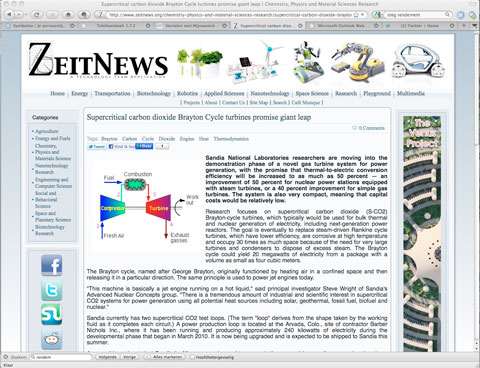Sandia Labs (US) is about to test a novel system of converting heat into power generation. The system is based on supercritical carbon dioxide and efficiencies of up to 50 percent are expected, offering a huge boost to power generation from both nuclear and solar heat.
“This machine is basically a jet engine running on a hot liquid,” explains Steve Wright, principal investigator of Sandia’s Advanced Nuclear Concepts group, in Zeitnews. What Sandia National Laboratories has developed is a special kind of Brayton cycle, in which air is compressed and mixed with fuel, then ignited in a combustion chamber after which it expands into a turbine, which may then drive a generator. What’s so special this time however is that the medium driving the generator is not exhaust gases but rather supercritical CO2 – a state in which CO2 has the density of a liquid but behaves very much like a gas. Like air, it is first compressed to 200 bar and then heated by an external source (nuclear or solar heat) to about 500 °C, after which it erupts into the turbine at full blast. The thermal to power conversion may consequently reach 50 percent efficiency, according to Sandia.
“It may even reach 60 percent at higher temperatures,” says Professor Piero Colonna, who lectures on energy systems at the faculty of Mechanical, Maritime and Materials Engineering. He explains that large solar thermal plants now use steam turbines to generate electricity with an efficiency of 25 to 30 percent. In short, the supercritical CO2 turbine could double the power output. And because of the very compact assembly, the investment could be much lower compared to existing technology. “The set-up is very compact,” Colonna explains, “and in our line of work investment costs are somewhat proportional to size.” The system could yield 20 megawatts of electricity from a package that has a volume as small as four cubic meters, according Zeitnews.
Professor Piero Colonna recently started to work with the Sandia team on the design of the compressor, a critical part of the chain, applying the results of his fundamental research on the fluid dynamics of supercritical gasses, which he initiated some years ago supported by an NWO Vidi grant.
For Colonna, supercritical CO2 cycles are ‘an emotional topic’, as it was his PhD supervisor, the Italian Professor G. Angelino, who in 1968 came up with the idea to improve energy efficiencies, although there was little interest in it at the time. During one of his trips to the United States, Colonna later discovered that MIT had dug up the study and passed it on to Sandia Labs. Prof. Colonna then followed the lead to New Mexico, where Sandia is working on the topic, and met with the researchers. Thus the collaboration on the design of the compressor arose.
Prof. Colonna has high hopes for this technology. When asked if supercritical CO2 is a dangerous medium to work with, he pauses before answering that it is not more dangerous than the pressurised steam that people have been working with for centuries. He expects the technology to be applied to boost solar power production.
Much to Prof. Colonna’s regret, Dutch industry is not yet involved in the development of the SCO2 turbine. “It demands a very high level of technology,” he says. “But developing it would cost only a fraction of what is invested in oil and gas technology. Companies should look 50 years ahead, not just five.”
De anammoxbacterie zet schadelijke ammonium samen met nitriet om in neutraal stikstofgas, bij voorbeeld in rioolwaterzuiveringsinstallaties.
Tot voor kort was het nadeel dat het afvalwater relatief warm moest zijn en het ammoniumgehalte zeer hoog, om voldoende effect te bereiken. Dit nadeel is nu echter ondervangen door bij de zuivering te werken met samengepakte bacteriën in korrelvorm. Die technologie werd al gebruikt in bepaalde industriële processen, maar blijkt nu ook succesvol in te zetten voor rioolwaterzuivering.
Volgens bioprocestechnoloog Prof.dr.ir Mark van Loosdrecht (Technische Natuurwetenschappen) biedt de ontwikkeling van het snellere anammoxproces uitzicht op een geheel nieuwe inrichting van het rioolwaterzuiveringsproces. Die nieuwe opzet bestaat grofweg uit twee stappen. In de eerste zuiveringsstap wordt organisch materiaal geconcentreerd, waardoor het kan worden gebruikt voor de productie van biogas (en dus energie). In de tweede stap komt het anammoxproces (in korrelvorm) aan bod, dat er voor zorgt dat ammonium effectief wordt verwijderd.
Van Loosdrecht: ‘Nu verbruiken we bij rioolwaterzuivering in Nederland ongeveer 16 kWh per persoon(equivalent) per jaar. Met deze nieuwe technologie kunnen we 9 kWh per persoon(equivalent) per jaar produceren.’ Op landelijke schaal zou dat 50 megawatt aan opwekking schelen, een kleine 10 procent van een gemiddelde kolencentrale.
In mei gaat op de rioolwaterzuivering Dokhaven in Rotterdam een pilot van start met de anammoxtechnologie.



Comments are closed.